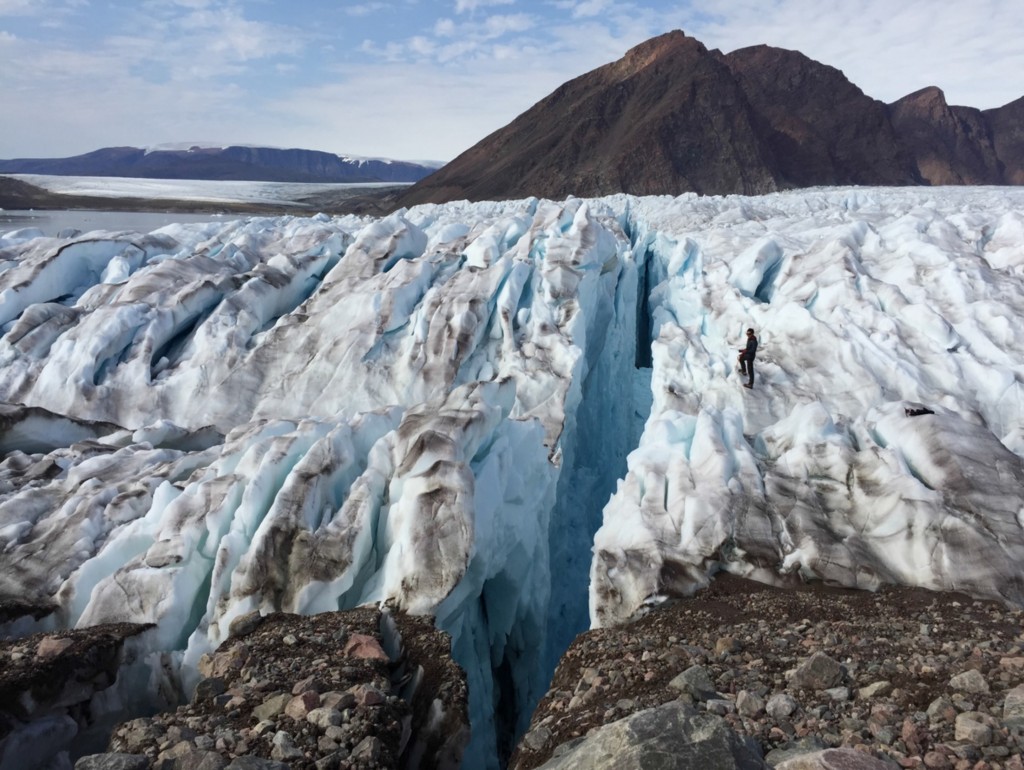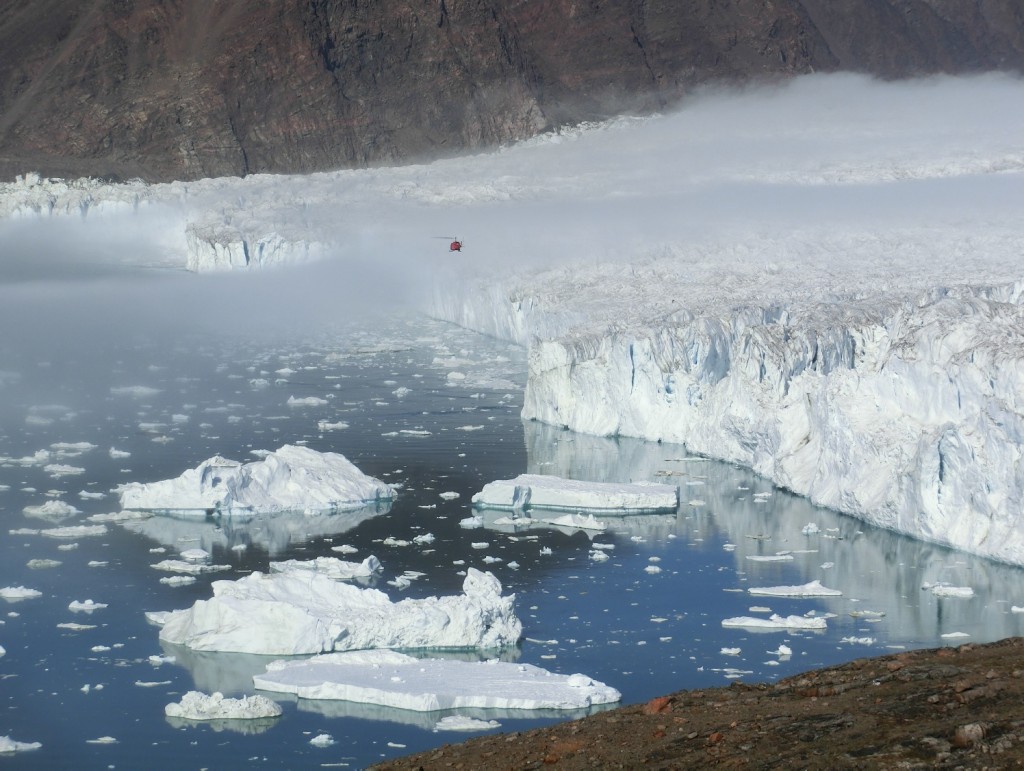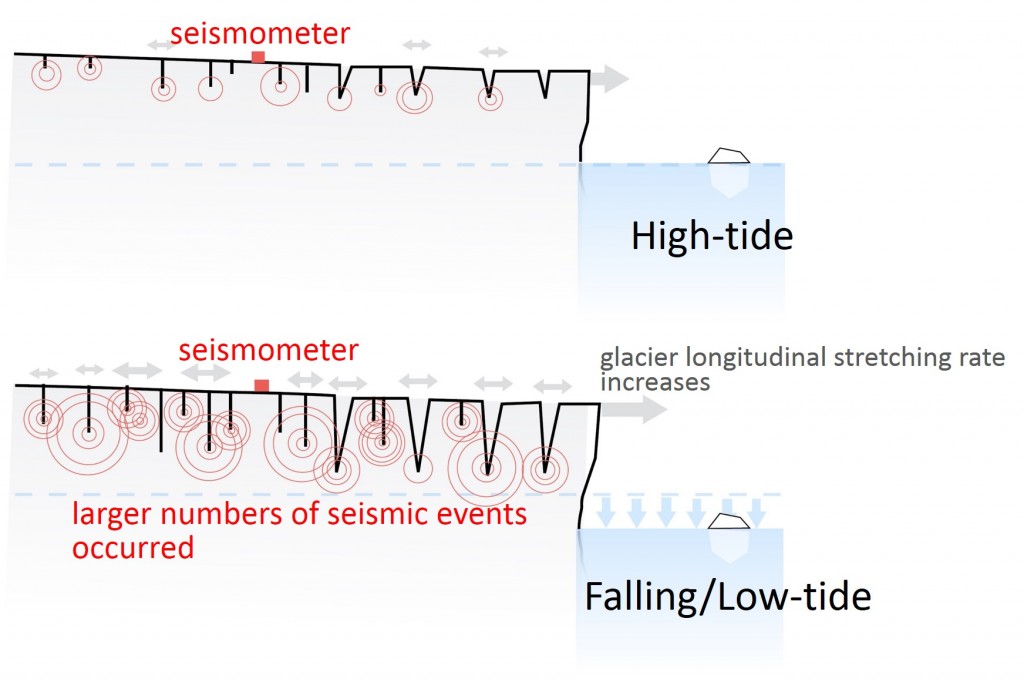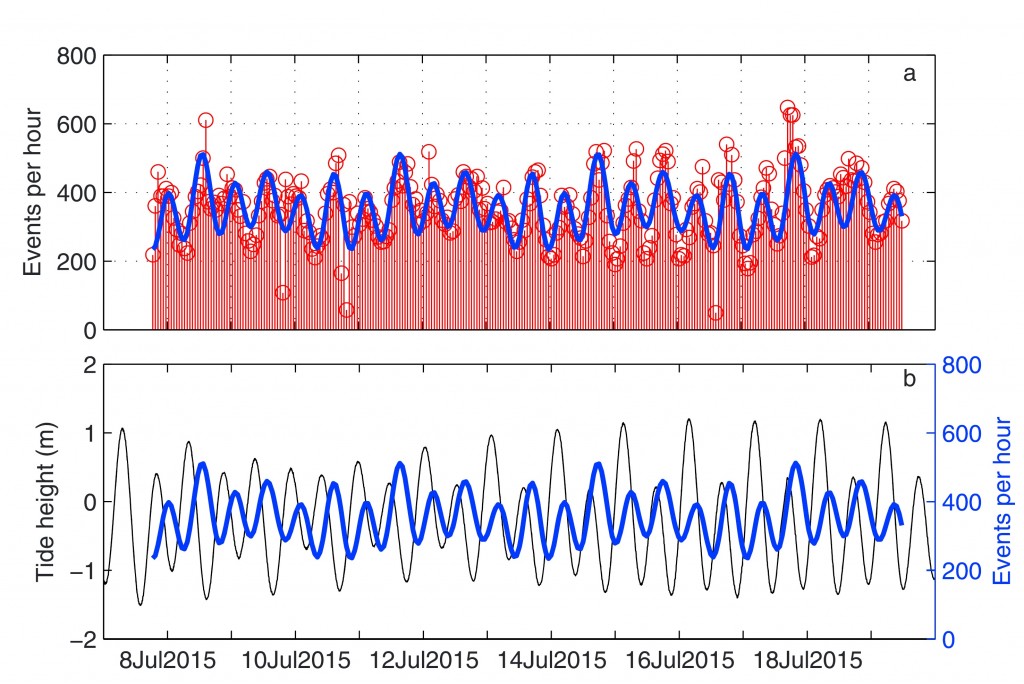Icequakes in Greenland
Research Press Release | March 28, 2016

Photo 1: Newly opened exceptionally-large crevasse near the calving front of the Bowdoin Glacier (note that the boulders and sediment are part of the central moraine resting on ice and do not represent the margin of the glacier; photograph by E. A. Podolskiy, 15 July 2015).
|
Key Points |
|
|
| Outline |
The remarkable spectacle of glacier crevasse formation has been known to polar explorers since the late 19th century, when Nansen [1897] reported “… a noise like the discharge of guns … and the earth tremble”. Nevertheless, until recently, massive ice bodies such as in Greenland and Antarctica have received little interest from seismologists due to the small numbers of local tectonic earthquakes. However, recent advances in seismic networks and seismometers installed directly on ice, have revealed many glacier-generated seismic events with magnitudes of —3 to 5 (or even 7). The monitoring of such events allows us to understand the response of glaciers and ice sheets to global warming, and to internal and other external factors. For example, a recent seismic analysis suggests that the dramatic process of glacier calving [https://youtu.be/U3F6kv3To3Y] is not as chaotic as it seems, and may instead be linked to temporal patterns of ocean tides [Bartholomaus et al., 2015]. A new study by Podolskiy et al., appeared in Geophysical Research Letters, a publication of the American Geophysical Union, provides a comprehensive analysis of icequake activity at a grounded tidewater-influenced calving glacier (Bowdoin Glacier in northwest Greenland). By installing seismometers directly on the glacier ice, just 250 m from the calving front, where icebergs are discharged into a fjord, along with high-precision GPS stations along the flow line, Podolskiy et al. recorded weak seismic emissions, that serve as a proxy for ice fracturing within the most dynamic part of a glacier. Such measurements are challenging and dangerous, as they require the installation and operation of instruments in a highly crevassed and difficult-to-access part of the glacier, as well as daily visits for maintenance and verification of instrument accuracy under high melt rate and new crevasse formation conditions. |
|

Photo 2: Calving front of the tidewater-influenced Bowdoin Glacier in northwest Greenland (note the people standing next to the ice cliff for scale; photograph by E. A. Podolskiy, 13 July 2015).
| Outline |
The observations reveal that the seemingly chaotic ice fracturing shows clear temporal trends, with microseismic activity defining a distinct double-peak daily oscillation, related to ocean tides. Such a pattern has been reported before in Antarctica; however, tides have continued to puzzle researchers. To identify the actual mechanism of icequakes has been challenging due to the existence of multiple non-exclusive mechanisms (such as bending of an ice shelf, resettlement of a glacier on its base, hydrofracturing, etc.) and a lack of observational data. Detailed records of ice surface speed show that the peculiar temporal pattern of microseismicity originates from variations in horizontal ice flow. On the one hand, ice slowly flows like thick honey via internal viscous deformation, whereas rapid deformation results in brittle fracturing, similar to glass. Such cracks are most common on the surface of glaciers and are called ‘crevasses’. Their opening releases elastic energy, that travels in the form of seismic waves through the ice and nearby rock. |
|
 Figure 1: Cartoon showing the calving front of the Bowdoin Glacier. The images illustrate the reason for more intense ice fracturing at falling/low-tide (and thus for larger numbers of seismic events) when glacier longitudinal stretching rate increases.
Figure 1: Cartoon showing the calving front of the Bowdoin Glacier. The images illustrate the reason for more intense ice fracturing at falling/low-tide (and thus for larger numbers of seismic events) when glacier longitudinal stretching rate increases.

Figure 2: (a) Number of detected events per hour at station ic2 during the period 7–19 July 2015. Solid curve shows fitted Fourier series with eight terms and R2= 0.54. (b) Corresponding tide height observed at Pituffik station, Thule (latitude 76.5434∘, longitude −68.8626∘; 126.5 km from the calving front). Neap/spring tides took place around 9/17 July 2015, respectively.
| Outline |
The Bowdoin Glacier is subjected to an extensional flow regime near its calving front, meaning that its front is continuously moving away from the ice higher on the glacier. This produces longitudinal strain and a divergence of about 2 cm per hour between two points separated by approximately 2 km. Moreover, the glacier movement is extremely sensitive to air temperature and tides: it flows faster during the heat of the day and at low tide, which is a time of reduced back-pressure on the ice cliff. This results in tidally modulated stretching, intensifying at falling tide and decreasing at rising tide. Higher stretching rates favor the tensile opening of crevasses and therefore generate large numbers of seismic events. Various mechanisms have been proposed to explain the tidal modulation of various earthquake phenomena in tectonic and glacier settings [Ide and Tanaka, 2014; Pratt et al., 2014]. The universality of the behavior observed at the Bowdoin Glacier is unclear, especially, in relation to the large floating tongues of Antarctic ice shelves, which may be affected by additional effects related to vertical bending. Understanding such dynamics is important in predicting the future response of glaciers to oceanic and atmospheric forcings. In addition, a better understanding of calving seismology could help identify precursory signs to hazardous mass failure in Alpine terrain, such as steep glaciers, landslides and rock falls. |
|
| Inquiries | Assistant Professor Evgeny PODOLSKIY
Cryosphere Research Group, Hokkaido University Arctic Research Center |
|
|
Japanese Link |
グリーンランドで海洋の潮汐によって発生する氷河地震を発見 (03.17.2016) | |
|
Publications |
Tide-modulated ice flow variations drive seismicity near the calving front of Bowdoin Glacier, Greenland, Geophysical Research Letters (03.08.2016) |
|
